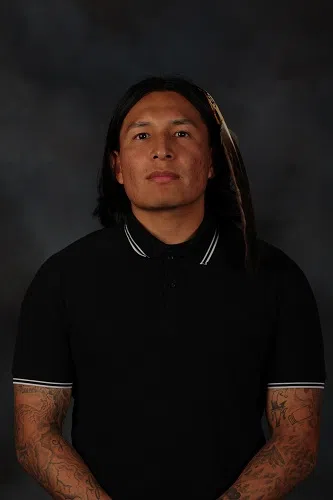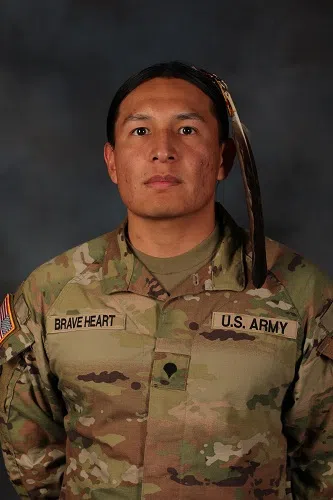Spc. Moses Brave Heart of the South Dakota Army National Guard’s 235th Military Police Co. has served in the national guard for the last five years and has begun the regrowth of his hair after finally receiving his exception to policy in August of 2023.
Brave Heart is a member of the Oglala Sioux tribe and grew up on the Pine Ridge Reservation for most of his life. He made the difficult decision to cut his hair to join the North Dakota National Guard in 2020 and transferred to the SDNG in April of 2024.
“I knew I wanted to go into law enforcement and the military and, at the time, thought well I can only do that with short hair and that’s how it’s got to be,” said Brave Heart.
When he joined, he initially didn’t know there was such a thing as a religious accommodation, and he originally accepted that the standards were set and there’s nothing really to do about it.
“I cut my hair knowing it was going to be for a good reason, for a career, so I made the sacrifice because I knew that if I kept it long, I wouldn’t be able to join,” said Brave Heart.
Within the Lakota culture, long hair is an extension of the spirit, typically only cut for grief and loss purposes, where it’s then buried or burnt. Apart from those types of circumstances their hair is grown and kept neat as it represents strength, connection to ancestors, memories, and joy.
“One person that really helped me a lot was Capt. Johnson, he was really excited about it and wanted to help me push it forward,” said Brave Heart, “I just gathered up whatever I could and gave it to him and he just put all the pieces together.”
Brave Heart was deployed in 2022-2023 and during this time learned of the possibility of an exception to policy. His journey began in October of 2022, and he credits Capt. Nathan Johnson, in the NDNG’s 131st Military Police Battalion, for his help as they worked on this passion project during the length of the deployment.
“The thing that really pushed me was that I wanted to be in uniform and also express my culture and long hair is significant in all Native American tribes; so being in the Army and being told ‘Be All You Can Be’ well this is a part of me, and Capt. Johnson was really excited and supportive to help me get this,” said Brave Heart.
In May of 2023, Brave Heart’s exception to policy was approved by the Department of Defense and he began to let his hair regrow. This expression of his Lakota culture also allowed him to embrace the opportunity to educate those around him and within his own culture on the strides military is making.
“In uniform there has definitely been some with an old mindset that staying disciplined means that men should have short hair in uniform, and sometimes the looks could really push someone to give up and be like ‘ok, I don’t want to do this anymore’, but I just turn it all into noise because I’m being strong in my beliefs and culture,” said Brave Heart.
Brave Heart went on to note that a part of being in the military is fighting for people’s freedoms and rights. He is focused on educating others through his experiences and that it’s possible to join the military without having to cut their hair. He also hopes that his journey will lead to a better understanding by his fellow citizen-warriors as to the cultural significance of their hair and why it’s important.
November is American Indian Heritage Month and its stories like these that help highlight the diversity and culture of the SDNG and the U.S. military forces in general. The educational opportunity and development of processes to support our forces’ diversity support the mission of a ready force and the connections in the community.

Spc. Moses Brave Heart of
the South Dakota Army National Guard’s 235th
Military Police Co. is pictured with his eagle feather
as he exercises his right to grow his hair out in
accordance to his religious beliefs and culture as a
member of the Oglala Sioux tribe and his exception
to policy in accordance with AR-600-20 and in
accordance with 1978 Indian Religious Freedom Act.
(U.S. Army National Guard photo by Staff Sgt.
Breanne Donnell)








Comments